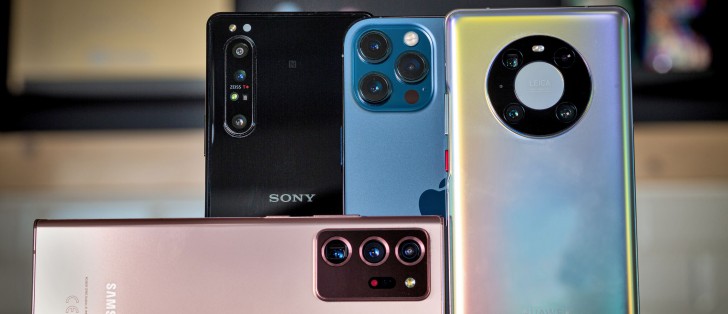Camera test: iPhone 12 Pro Max vs. Mate 40 Pro vs. Xperia 1 II vs. Galaxy Note20 Ultra

Selfies
The iPhone and the Mate have the most likable skin tones when it comes to selfies in our book. The Mate does walk a fine line between pleasing and too pink, and its saturation is the highest in general - skin tones and all, but we are okay with it. The Xperia and the Galaxy are more conservative, so you'll look closer to your pale self with those, barring using the skin enhancements.




Selfie samples: Galaxy Note20 Ultra • iPhone 12 Pro Max • Mate 40 Pro • Xperia 1 II




Selfie samples: Galaxy Note20 Ultra • iPhone 12 Pro Max • Mate 40 Pro • Xperia 1 II
The iPhone would be our top choice for detail rendition, beating the Galaxy and the Mate. We'd say it resolves a bit more facial hair and pores next to the Note20 Ultra's more smeary rendition. At the same time, the Mate has roughly the same amount of pixels to allocate to a wider frame, so it's at a slight disadvantage by design. The Xperia can't really compete for detail - it's about time Sony replaced this module with something altogether nicer.
All four selfie cams have an excellent dynamic range thanks to auto-HDR processing though the Xperia is somewhat behind. The Galaxy usually doesn't have issues with dynamic range in contrasty scenes, but in overly demanding backlit scenarios, in particular, it joins the Xperia in coming up with darker faces and, by extension, harder to like selfies than the other two.
The iPhone and the Mate both excel at backlit shots, serving up tonally well-developed faces, all the while keeping the background highlights in check. However, that takes a significant toll on the Mate's facial detail, where we see excessive sharpening. The iPhone is more refined in this respect.




Selfie samples: Galaxy Note20 Ultra • iPhone 12 Pro Max • Mate 40 Pro • Xperia 1 II




Selfie samples: Galaxy Note20 Ultra • iPhone 12 Pro Max • Mate 40 Pro • Xperia 1 II




Selfie samples: Galaxy Note20 Ultra • iPhone 12 Pro Max • Mate 40 Pro • Xperia 1 II
Selfie portrait photos
The iPhone's portraits come out in 7MP with a cropped-in frame, while the Mate only allows bokeh effects at the digitally zoomed-in 1.0x setting, though it still outputs images at 13MP. The Galaxy lets you choose between the native field of view of the camera or the cropped-in one, where the resolution is 6.5MP. The Xperia's selfie portraits are the same size as regular selfies.
Not the same dynamic range, however - the Sony can't do HDR when taking selfie portraits and backlit shots are problematic. The Galaxy, too, continues to struggle in such situations and renders faces darker than we'd like. Certainly darker than the iPhone and the Mate, which continue to deliver significantly better-exposed faces.




Selfie samples: Galaxy Note20 Ultra • iPhone 12 Pro Max • Mate 40 Pro • Xperia 1 II
Our pick for subject isolation would be the Mate, which makes a precise distinction between subject and background in casual scenes. It properly amazed us with the way it handled the hair in the scene above - compare its sharp rendition at the top to the blurred out stray hair on the iPhone and the Galaxy. You can see it in this next sample too, which we've somehow missed shooting on the Xperia.



Selfie samples: Galaxy Note20 Ultra • iPhone 12 Pro Max • Mate 40 Pro
Meanwhile, the iPhone can be a bit iffy around shoulders and clothing, like in the first sample below against the brick wall in the distance. Our wooden wall paneling strikes again and strikes them all, Mate included, however.




Selfie samples: Galaxy Note20 Ultra • iPhone 12 Pro Max • Mate 40 Pro • Xperia 1 II




Selfie samples: Galaxy Note20 Ultra • iPhone 12 Pro Max • Mate 40 Pro • Xperia 1 II




Selfie samples: Galaxy Note20 Ultra • iPhone 12 Pro Max • Mate 40 Pro • Xperia 1 II
Low-light selfies remain among the lagging bits in smartphone photography, but let's see where these ones stand. This first shot is mostly for gaining perspective on just how dark it was in the test scene, though a case could be made that this is about as much light as you'd have in a bar. None of these photos we'd really consider usable.




Low-light selfie samples: Galaxy Note20 Ultra • iPhone 12 Pro Max • Mate 40 Pro • Xperia 1 II
Screen flash to the rescue, even if your mates might (rightfully) object to such practices in social settings. The iPhone is the least enthusiastic about exposing your face properly, and we know it's not for lack of nits in that display - as such, it doesn't make a huge difference, though you could consider the photo salvaged.
The Mate and the Galaxy, on the other hand, do light up your face nicely, even if the Mate has messed things up with white balance and turned a gray T-shirt blue. The Xperia gets the face reasonably lit, though that doesn't help deliver a sharp photo.




Low-light selfie samples, screen flash: Galaxy Note20 Ultra • iPhone 12 Pro Max • Mate 40 Pro • Xperia 1 II
All but the Xperia have Night mode for selfies too. In this particular scene, the iPhone and the Galaxy did lift up the shadows on the dark side of the face, nudging the photo into barely usable, while the Mate did little besides imposing a crop on you.



Low-light selfie samples, Night mode: Galaxy Note20 Ultra • iPhone 12 Pro Max • Mate 40 Pro
Selfie video recording
Three out of four phones here can record video up to 4K resolution at 60fps with their selfies - the Mate, the iPhone, and the Galaxy. The Xperia, meanwhile, maxes out at 1080p/30fps.
Stabilization is available on all phones, in all modes. That comes with a caveat on the Mate, which has three magnifications in selfie video recording - the widest, which is also its native, isn't quite as well stabilized as its other two narrower ones are properly smooth.
The iPhone's stabilization is impeccable, as usual, while the Galaxy can suffer in fast pans or if your walking style has a bit of a march to it. The Xperia smooths out walking well but has this weird effect where pans take a split second to catch up, and framing your mug is a bit off in these moments.
We'd say video quality is best on the iPhone. It has the most detail in the face, for better or worse (we do like detail, wrinkled as the subject maybe), and has the most pleasing skin tones. The Galaxy comes next for detail, though with a slightly less appealing tint to the face, and the Mate has nice colors but not so much fine texture.




Video screengrabs: Galaxy Note20 Ultra • iPhone 12 Pro Max • Mate 40 Pro • Xperia 1 II
Additionally, the Mate's very short focal length means it has a considerable depth of field. So if you're after isolating your subject (yourself) from the background, you should look at the Note20 Ultra, which is most adept at that thanks to a combination of relatively large sensor, relatively big aperture, and autofocus. It's no Zenfone 7, but it's the thinnest DoF of this bunch.
However, the Mate's ultra-wide camera can't be beaten for coverage, and that's no small advantage for vlogging. Perhaps the widest setting may be too wide, and the trade-off with stabilization may not be worth it, but the mid-way 0.8x is probably just the perfect compromise.




Video screengrabs: Galaxy Note20 Ultra • iPhone 12 Pro Max • Mate 40 Pro • Xperia 1 II
The iPhone wins for dynamic range, which is most apparent in backlit scenes. The Mate can recover the highlights in photos, but not so much in video, which isn't helped by the very wide field of view that gets all sorts of contrast in the frame. It still gets your face well exposed, which is most important. The Galaxy exposes for your face better in video than in stills, seemingly, and the Xperia is, well, not on this level.
Here's a playlist of all four videos we shot. We limited this comparison to just 4K30 (1080p30 on the Xperia) for the sake of brevity and because it's the most apparent mode to use, but the findings apply just as well to the other modes.
Reader comments
- Hossien
- 28 Apr 2023
- cSx
No phone in the world can take pictures as well as a camera, a phone is something that is always available. The camera is not always available, but the phone is everywhere. If a random scene happens, the camera is not available to you, you have to ...
- Anonymous
- 03 May 2022
- fD9
imma tell you what, i know a thing or two about taking photos and i would take a proper camera over this
- Anonymous
- 06 Mar 2022
- Y7I
That's why I have a Sony RX100 VI for trips and outings when I want better pictures than with my phone. I can zoom in optically a lot and it has a nice picture quality. No need for a DSLR unless you are a paid photographer or need it for work or...